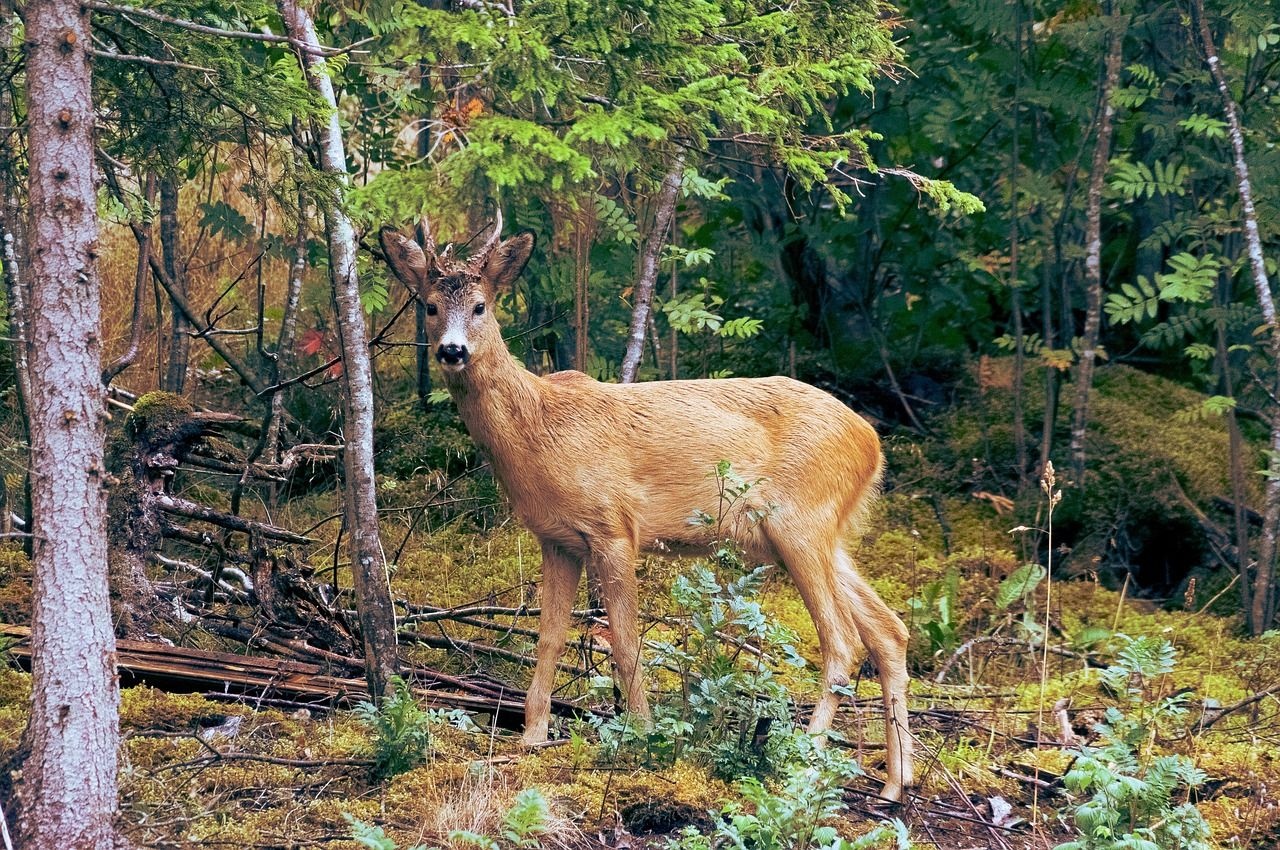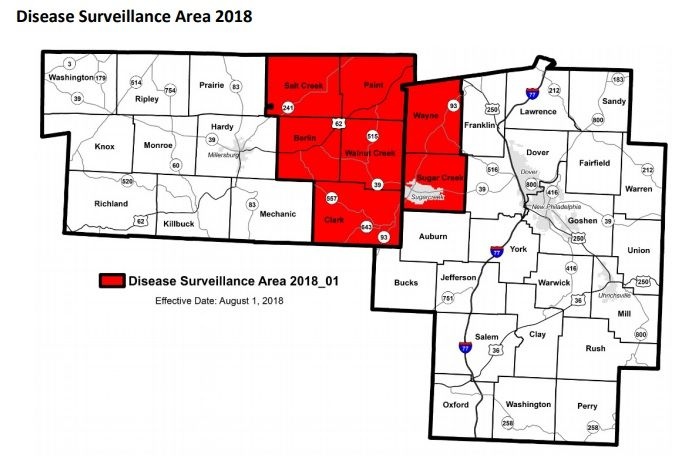
Columbus, Ohio - The Ohio Department of Natural Resources is reaching out to area hunters to help it monitor local deer populations and prevent the spread of Chronic Wasting Disease.
Chronic Wasting Disease, or CWD, is a fatal neurological disease that affects the central nervous system of cervids, a classification that includes all species of deer, moose and elk.
CWD is part of a family of diseases known as transmissible spongiform encephalopathies caused by rogue proteins known as prions that can be passed from directly from animal to animal or shed into the environment through bodily fluids. Similar diseases include mad cow disease, scrapie in sheep and Creutzfeldt-Jakob Disease, or CJD, in humans.
Mike Tonkovich is the Deer Program Administrator for ODNR’s Division of Wildlife. He says CWD can be transmitted in a multitude of ways.
“It can be shed in the urine, feces and blood as well, and that contaminates the environment, and then, of course, another animal could come along and ingest it. These prions can attach to the soil. They bind to the soil. They can be taken up by plants and be moved across the country and then consumed elsewhere,” he says. “We know that scavengers such as crows or coyotes feeding on a carcass and that deer was positive, if that crow or that coyote were to consume the right part, they’re capable then of moving those prions across the landscape.”
CWD first appeared in the state in 2014 when it was detected in an adult buck taken on a Millersburg shooting preserve. It has since been detected only in captive deer facilities, however, state wildlife officials are concerned about the potential for the disease to spread to the wild deer population.
Tonkovich says the concern is not only that the disease will spread from captive deer to the wild deer population but also that it will spread from wild deer to captive animals.
“Most of these facilities in Ohio are not double fenced. There’s just a perimeter fence, and there’s nothing around the perimeter of these facilities, which allows interaction between wild deer and captive deer. We need to be mindful of the fact that the disease can move both ways through that fence,” he says.
The most recent cases of the disease were confirmed earlier this year in a captive breeding facility in Holmes County. In response, ODNR has created a disease surveillance area, or DSA, within a six-mile radius of the breeding facility and implemented new carcass rules for hunters who hunt wild deer, elk, caribou and moose in other states.
The newly-established DSA includes Wayne and Sugarcreek townships in Tuscarawas County and Salt Creek, Paint, Berlin, Walnut Creek and Clark townships in Holmes County. The designation will remain in effect for a minimum of three years and requires hunters to bring any deer carcasses harvested within the DSA boundaries during the deer-gun and deer muzzleloader seasons to an ODNR Division of Wildlife inspection station for sampling.
Two locations have been designated as Carcass Inspection Stations: Sugarcreek Village Hall at 410 South Broadway in Sugarcreek and Walnut Creek Township Garage at 2490 TR 414 in Dundee. Both stations will be staffed daily between the hours of 10 a.m. and 8 p.m. during this year’s deer-gun and deer muzzleloader seasons.
Upon arrival to an inspection station, hunters will be asked to provide a confirmation number from the game check process as well as the location where the deer was killed. Tissue samples will be then taken and tested for CWD. Tonkovich says the entire process takes less than 10 minutes to complete.
“It’s a relatively painless process for the hunter,” he says.
Tonkovich notes that the testing requirement does not apply to carcasses harvest during the deer-bow season, which begins this Saturday, September 29, or during the youth hunting seasons, although there will be several locations where hunters can voluntarily bring their carcasses for testing.
“We can make arrangements to have those dropped off at a couple different drop locations. One of those is the Millersburg Fire Station and the other would be our headquarters at the Killbuck Wildlife Area on the Wayne-Holmes county line. Those would be available Monday through Friday during regular business hours,” he says.
Other rules that apply to individuals hunting within the DSA boundaries prohibit the placement or use of salt, mineral supplement, grain, fruit, vegetables or other feed to attract or feed deer, and from hunting with the aid of these substances. Feeding or baiting may cause deer to concentrate in a particular area and facilitate the spread of CWD.
Normal agricultural activities including feeding of domestic animals as well as hunting deer over food plots, naturally occurring or cultivated plants and agricultural crops are not prohibited.
Hunters are also prohibited from removing a deer killed by a motor vehicle within the DSA boundaries unless the carcass complies with deer carcass regulations. Information on carcass regulations can be found at wildohio.gov.
In addition to the rules for those hunting within the DSA boundaries, ODNR has also implemented a new, statewide rule that prohibits the transportation of high-risk carcass parts into Ohio from any state or Canadian province, regardless of the CWD status of the exporting jurisdiction. High-risk carcass parts include the brain, eyes, spinal cord, lymph nodes, tonsils and spleen of CWD-susceptible species including mule deer, white-tailed deer, Rocky Mountain elk and moose.
“You cannot possess any of those from out-of-state deer or CWD-susceptible species effective immediately. The purpose there is to try to decrease the likelihood of a hunter harvesting a CWD-positive animal in another state or in Canada and bringing it back. It’s not the transport safety that’s so much of a concern of ours as it is the disposal of the carcass when they get here,” he says.
With the carcass rules, Tonkovich says enforcement is going to be secondary to education, at least for this year.
“We just want to make folks aware of proper disposal. We’re not going to write tickets. We’re not going to close businesses down. Taxidermists and processors can still continue to function as they have, provided those parts are disposed of properly in one of Ohio’s 27 lined municipal landfills,” he says.
The DSA carcass testing requirements, however, will be strictly enforced.
“Enforcement will be a very big part of that, and it would certainly be an option or law enforcement staff will exercise if they need to,” Tonkovich says. “If you blatantly break the law, enforcement and a summons is an option for our law enforcement staff.”
Hunters with questions about the DSA requirements or the new carcass rules are invited to call 800-WILDLIFE or the Wildlife District Three office at 330-644-2293 for additional information.
While there is no evidence at this point that CWD can be transmitted to humans, hunters are being advised to use common sense precautions and avoid consuming high-risk carcass parts. Recommended precautions include not shooting any animal that appears sick, wearing rubber gloves when field dressing carcasses, minimizing the handling of brain and spinal tissues, and washing hands and instruments thoroughly once field dressing has been completed.
STACEY CARMANY, TUSCO TV

